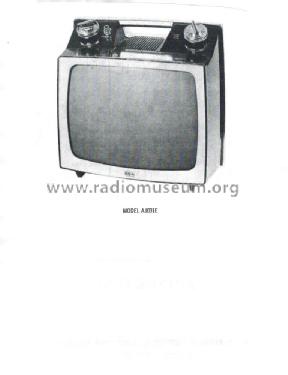- Country
- United States of America (USA)
- Manufacturer / Brand
- RCA (RCA Victor Co. Inc.); New York (NY)
- Year
- 1966
- Category
- Television Receiver (TV) or Monitor
- Radiomuseum.org ID
- 150139
-
- alternative name: RCA Manufacturing || Victor Talking Machine
- Number of Tubes
- 1
- Valves / Tubes
- unknown_Tube
- Number of Transistors
- 26
- Semiconductors
- Main principle
- Superheterodyne (common)
- Power type and voltage
- Alternating Current supply (AC)
- Loudspeaker
- Permanent Magnet Dynamic (PDyn) Loudspeaker (moving coil)
- from Radiomuseum.org
- Model: KCS153X - RCA RCA Victor Co. Inc.; New
- Shape
- Tablemodel without push buttons, Mantel/Midget/Compact up to 14
- Dimensions (WHD)
- 13 x 12.25 x 10.9 inch / 330 x 311 x 277 mm
- Notes
- The RCA model KCS153X is most probably the first IC television set. According to the "PS buyer's guide to small-screen transistor portable TV's" in "Popular Science" on page 111 (December 1966) the KCS153X uses 26 transistors, 17 diodes, 1 vacuum rectifier and the IC CA3013 from RCA. The CA3013 is used for the tonal IF incl. limiter, FM detection and audio amplification. The diagonal inches of the screen: 12 (74 square inches). Heathkit GR-104 is also named as TV-kit fitted with an IC at that time and in Spring 1967 Heathkit sold the AR-15 AM-FM radio with two ICs CA3012 from RCA. According to "Funkgeschichte" the KCS153X was the first application of an IC for radio or/and television ever, presented in March 1966 (but market introduction was later that year. According to "Electronics World" from November 1966 on page 44 to 46 it was General Electric which introduced then the first IC radio ever as model P1740. Philips was the follower in Europe for an IC radio - with the model IC2000 - introduction "Funkausstellung" 1967 and Blaupunkt with it's TV set "Sevilla" "Hannover-Messe" 1967 - with the CA3012 from RCA.
- Price in first year of sale
- 130.00 $
- Mentioned in
- Funkgeschichte der GFGF (number 86, year 1992, page 245)
- Literature/Schematics (1)
- Photofact Folder, Howard W. SAMS (957-2 (1968))
- Author
- Model page created by Ernst Erb. See "Data change" for further contributors.
- Other Models
-
Here you find 5118 models, 3224 with images and 4148 with schematics for wireless sets etc. In French: TSF for Télégraphie sans fil.
All listed radios etc. from RCA (RCA Victor Co. Inc.); New York (NY)
